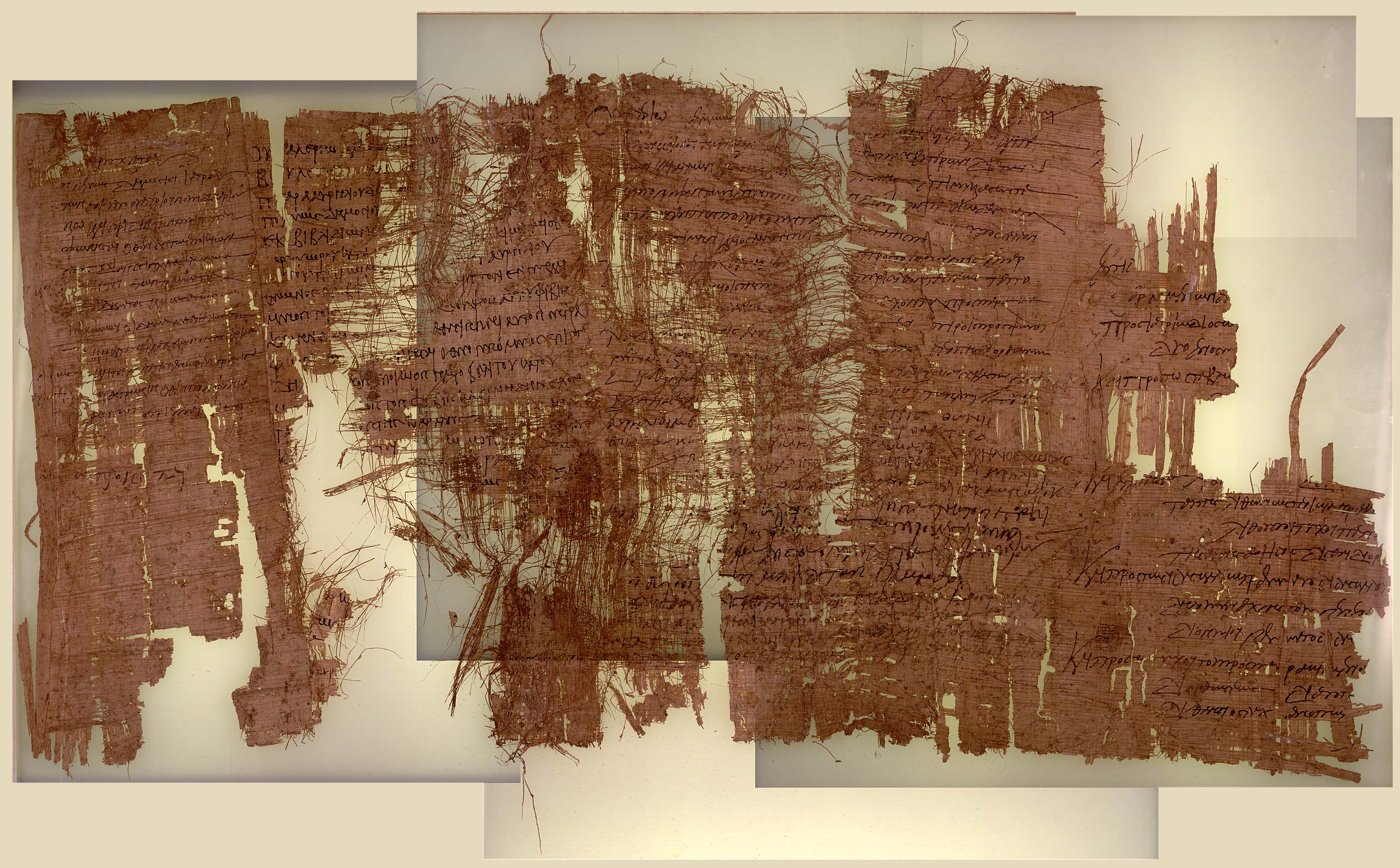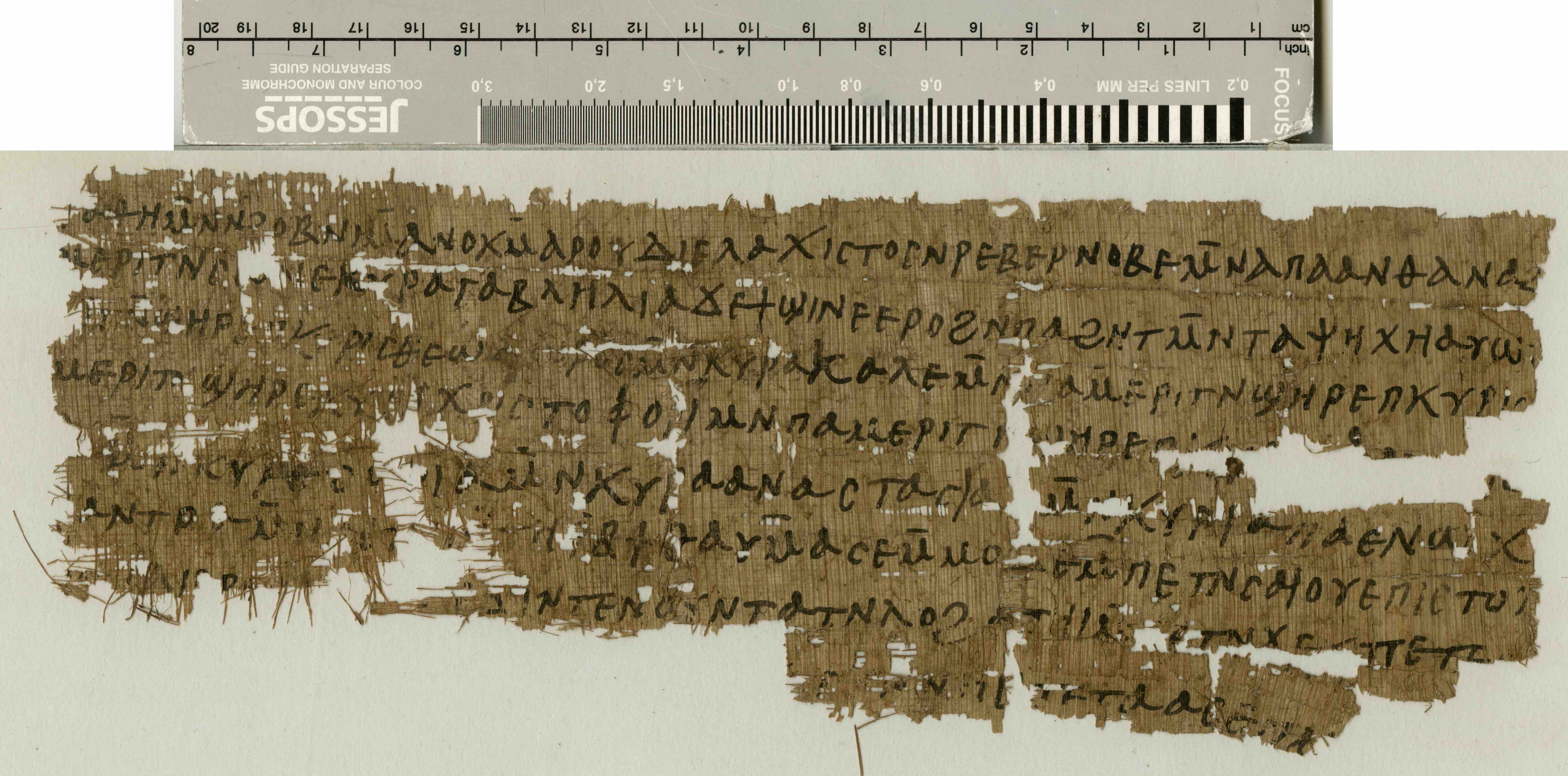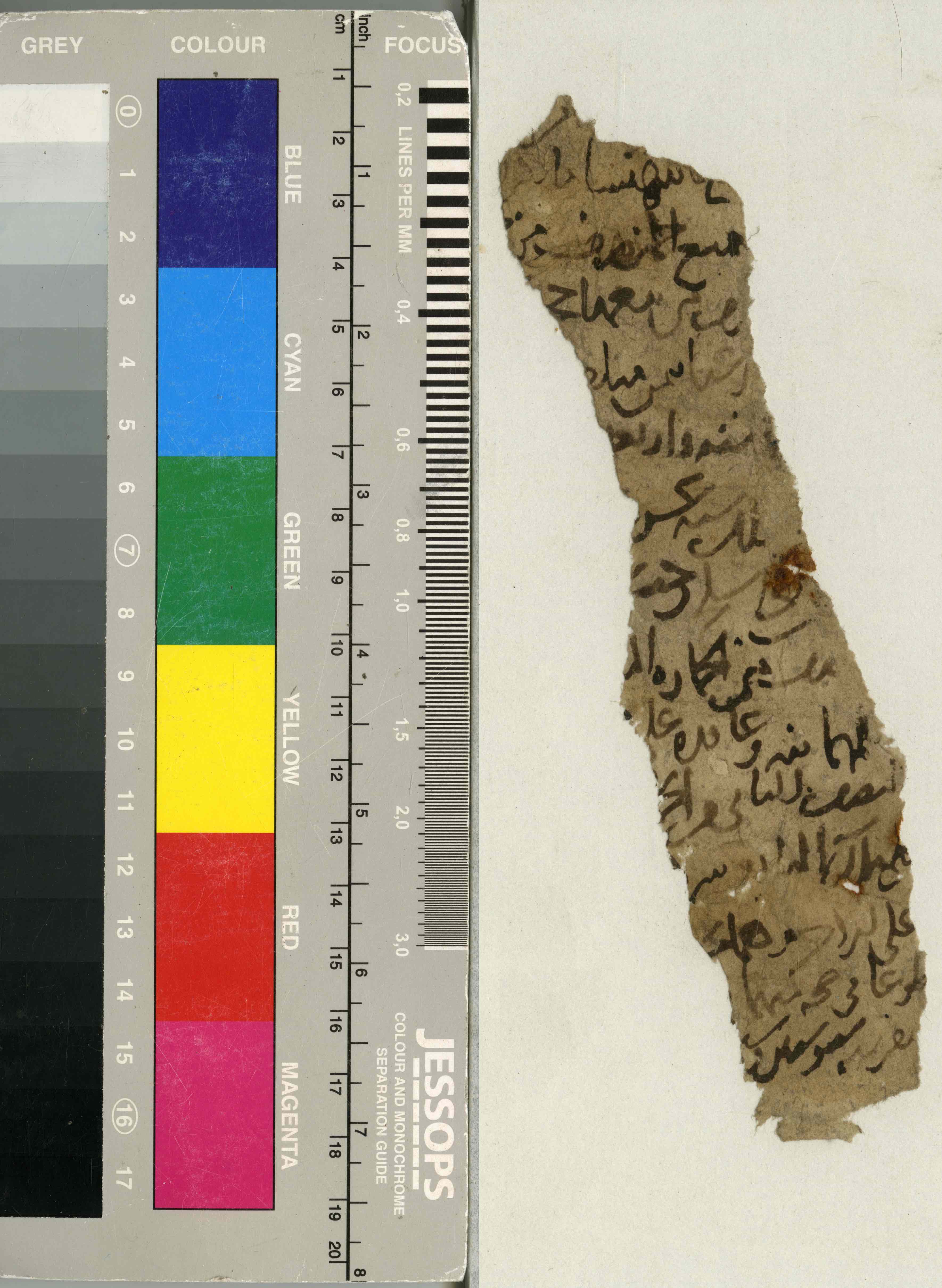A Millennium of Documents
Very few papyri of Ptolemaic date (roughly 3rd–1st centuries BC) have survived from Oxyrhynchus, for reasons not fully clear but probably largely to do with the underground damp level. This relatively late cession, by a cavalryman called Theon, is one of the better-preserved examples. It is displayed here for its part in showing how documentary handwriting styles changed in the 700-year span covered by the papyri in this section.
Latin is comparatively rare in papyri from Egypt. Most commonly it is used in documents concerned with Roman citizenship or the army. Chius, the recipient of this letter, is named in the address on its back as Chio Caesaris, ‘to Chius (slave) of Caesar’. Imperial slaves played an important part in the civil service of the Empire, particularly in financial matters.
Words are separated by dots, a common practice. Lines 4–5 run crede . mihi . nimia . bonitas | pernicies . hominibus est, ‘Believe me, excessive goodness is a disaster for mankind’, and then the scribe has added above the line vel . maxsuma (= maxima), ‘even the biggest’.
The precise purpose of this ‘list of sacred net-fishermen of Athena Thoeris’ remains unclear, but it adds to the evidence for the amalgamation of Greek and Egyptian cults and perhaps for the varieties of animal-worship so popular in Egypt, since there may have been a fish cult connected with Thoeris.
Eleven fishermen are listed under the headings of various districts of Oxyrhynchus. The text is not dated, but is assigned to the first century on the basis of the script.
Papyri from Egyptian rubbish dumps do not often directly involve the great leaders of the Roman state. This one is an exception, although the semi-literary hand may indicate that it was a copy for propaganda purposes rather than a true document. It records a speech to the citizens of Alexandria by an imperial visitor who can be identified as Germanicus, nephew of Tiberius, probably in AD 18 or 19.
On the back and probably by the same scribe is a later copy of the minutes of an audience given by the emperor Augustus in Rome to ambassadors from Alexandria. The audience took place probably between January and August, AD 13.
This fragmentary item is one of the earliest documents attesting the existence of a senate at Oxyrhynchus. (The foundation of this institution in the Egyptian metropoleis goes back to the visit of Emperor Septimius Severus to Egypt in AD 199–200.)
The interest of the document actually lies in the lines which have been inked out. They are part of an imperial set of titles originally featuring Emperor Septimius Severus associated with his two sons Antoninus (the future Caracalla) and Geta, who were proclaimed as joint successors. But a decade later, after Severus' death, Geta was killed by his brother, who claimed to have escaped a plot to poison him. After this event Caracalla became the only Emperor. Then all images of Geta were destroyed (even the coinage displaying him was melted down) and his name was erased from every official document and inscription in the Empire, together with the name of several murdered relations, as in this papyrus here on display. This process is called damnatio memoriae, which means 'condemnation of memory'.
Part of a large public notice of dedication to the emperors, on the part of a detachment of the Fifth Macedonian Legion. When complete the papyrus must have been around three times its present width. It may have served as the actual notice, or it may have been the full-size draft which a mason would cut in stone.
A roll of reports to the senior civic official in Oxyrhynchus, Valerius Ammonianus alias Gerontius. The initial columns (not shown) were published or partly published by Grenfell and Hunt in Part I of The Oxyrhynchus Papyri (no. 53) in 1898, and are now housed in the British Library and in Trinity College Dublin. The rest of the roll was published in volume LXIV of the series (1997), so that the roll effectively links the first volume with its own centenary.
The preserved portions cover columns 104–119, so that the roll was once immensely longer than what you see here. Its minimum length can be calculated as around 20 metres, and rolled up it would have had a diameter of at least 12 centimetres.
Two of the items are doctors’ reports, detailing the injuries sustained by wounded persons. The rest refer to buildings, many of them not recorded before, listing either the repairs needed or the building materials needed for the repairs. The buildings were in or adjacent to the East, West, North and South Stoas, a stoa being a covered colonnade. It seems that these colonnades formed the four sides of a very large square. It may not be too fanciful to see the remains of the colonnade discovered by Petrie in 1922 as part of the Northern Stoa.
This substantial piece preserves the complete verbatim report of complex legal proceedings held before the senior municipal official in Oxyrhynchus whose name (Flavius) Leucadius is given in a docket on the back. It is written down the roll, an early example of this common mediaeval format.
A special interest attaches to the date; it can be calculated that 2 October AD 325 was a Saturday. A decade or so earlier, government officials took Thursdays off. Here towards the end of the document (lines 36 ff.), at a time that can be calculated as around 5.40 p.m., it is announced that since the next day was the Lord’s Day, the hearing would be resumed on the day following. This text is both the earliest reference to the Lord’s Day in papyri and the earliest practical attestation of Sunday observance. That goes back to an edict of the emperor Constantine in AD 321, but the history of imperial dynastic events meant that Constantine’s edict would not have been effective in Egypt until late 324, a year before the date of this papyrus.
These proceedings were written on ‘waste paper’: on the back are seven columns of declarations of commodity prices by some of the local guilds six years before, part of a failed attempt by the government to control inflation.
This handsomely-written sheet, lacking its line beginnings, preserves part of another report of proceedings, perhaps before the provincial governor. The report is bilingual, Latin with Greek, the framework (date, place, speakers’ names) being in Latin and the words spoken being in Greek (the language in which they were doubtless spoken), a regular format for reports of proceedings before higher authorities in the fourth and fifth centuries.
The hearing was held in the city of Pelusium, at the north-east angle of the Delta: the name is clearly visible abbreviated as pel. in the top line. Answers to the court’s questions could be short and to the point: the little group of letters seven lines down was eventually deciphered as R with an abbreviation stroke, for r(espondit), ‘he replied’, followed by Greek nai, ‘yes’.
This rare item is an original letter from the chancery of Flavius Julius Ausonius, governor of the province of Augustamnica in Egypt. It is addressed to two leading citizens of Oxyrhynchus and concerns their misconduct in tax-collection. The governor has himself added a word at the end of line 8. Below that is the consular date in Latin; in the left margin, also in Latin, is the day by the Roman calendar and the place of writing, Heracleopolis to the north of Oxyrhynchus.
The impressively stylised script is of special interest. The only similar document to have survived in a good state of preservation is a letter in the Berlin collection from the governor of Egypt in AD 209. Although this document and Ausonius’s letter are nearly a century and a half apart in date, the scripts are remarkably similar.
This contract from the Apion family papers (cf. next item) is exhibited to show the so-called protocollon on the left. This was a sheet attached to the beginning of a roll with its fibres at 90° to the rest of the roll, occupied with up to five or six lines of stylised script which functioned as a form of government stamp. An imperial decree had required contracts to be drawn up on rolls so prefaced, a requirement that was only sporadically observed.
This excerpt is from a roll measuring almost 3 metres in length. The papyrus was kept in a box of material belonging to the collection, still rolled up, and was unrolled in 1981. It is thought to be one of the "fine rolls three to ten feet long" from a large haul of Byzantine papyri brought back by Grenfell and Hunt from their first season of digging at Oxyrhynchus.
The roll preserves the accounts of a steward on an estate of the immensely wealthy Apion family. Sums are given in gold. The steward's name is Theodorus. Unusually for ancient accounts, his figures are scrupulously accurate, and the document contains some interesting asides on boatbuilding, irrigation works, and oil manufacture. Even larger sums are mentioned in another similar account on the back, published as LV 3805.
A complete text exhibiting a script which is comparatively rare in the collection. It may well belong to the seventh century, not long before the Arab conquest of Egypt.
The text records the dimensions and then the capacity of excavations in preparation for the construction of a water tank which would probably have been stone-lined and vaulted; a sum in gold follows, presumably the payment for the digging work.
This item dates from a period when Egypt was occupied by the Persians, and is a receipt addressed to one Marinus for the payment of a large quantity of gold coin, perhaps £500,000 at today’s prices, in part-payment of the taxes for one year levied on Oxyrhynchus and a smaller neighbouring town.
This is one of the very latest dated Greek texts to survive from Oxyrhynchus. Around twenty years later, it is conjectured that the city was attacked and sacked by the invading Arab forces. At any rate, the collection contains no texts, whether Greek or Arabic, from the next two hundred years, suggesting that Oxyrhynchus became a ghost town until its rebirth as the Islamic town of Bahnasa at the end of the ninth century.
Many languages other than Greek and the occasional Latin piece are represented in the papyri recovered from the rubbish mounds of Oxyrhynchus. Among them is Coptic. This late development of Egyptian written in Greek characters (plus a few special extra ones), frequently incorporating Greek words as well, became closely associated with Christianity. It was used for private letters, occasionally for other documents such as contracts, and for Biblical and other theological texts.
This letter was sent by a woman named Marou, who calls herself 'the least of sinners', to another woman named 'Lady Gableria', presumably a deformation of 'Gabrielia'. It consists mostly of greetings to others.
P.Oxy. inv. α 3/AK (A. 511). Published: A. Alcock, 'Two Coptic Letters from Oxyrhynchus', Orientalia N.S. 62 (1993) 83–88.
Another language occasionally represented in the collection is Pahlavi, the language of the Persians who occupied Egypt for a short period in the early seventh century. Few of the fragments are of great extent, so that in view of the characteristically large brushed script very little text is preserved. For an image of a papyrus in Pahlavi, see here.
The site has produced substantial quantities of written Arabic material, although the Oxyrhynchus collection does not contain as much of this as it might have done, because Grenfell and Hunt were concerned with the Graeco-Roman period and therefore aborted excavation in areas that were proving to contain only Islamic-period rubbish. Little of this material has been published; a preliminary inspection suggested dates ranging from the late 9th century to the 15th century AD. Since the site has produced few Greek papyri that clearly postdate the 640s (the period of the Arab invasion), this suggests a period of more than two centuries during which the site was sparsely occupied.
This paper fragment is from a contract of sale for a half share of a donkey and a half share of a colt and is dated to Ṣafar 666 AH = 22 October–20 November AD 1267.


















